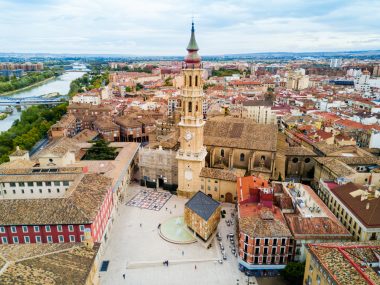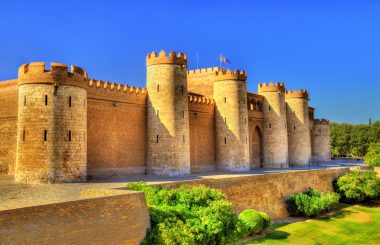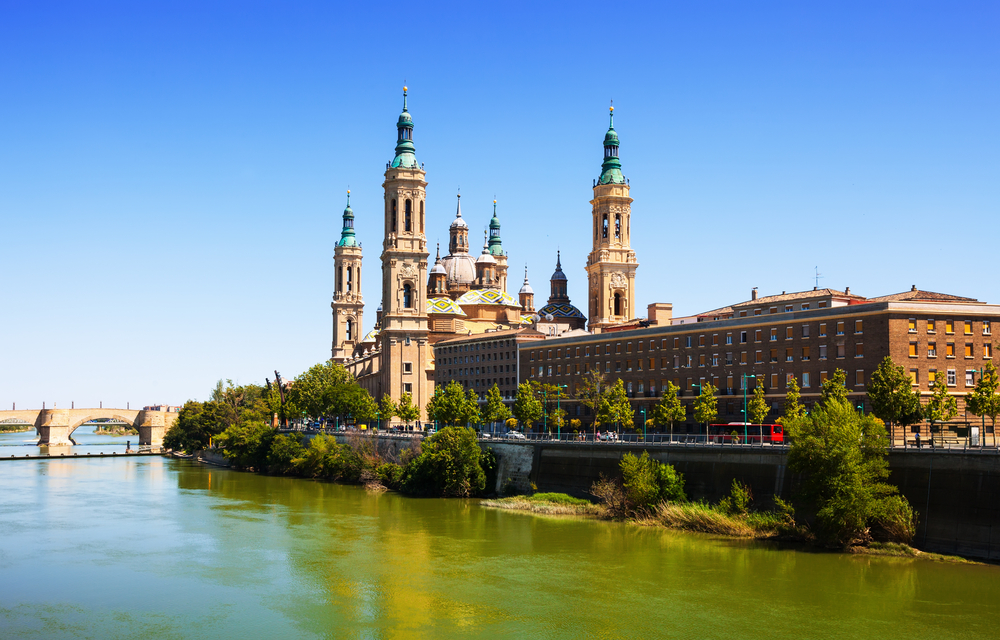Zaragoza, one of the largest cities in Spain today, looks back on an eventful history. Initially, the Romans settled in the northern Spanish city. Even today, Roman ruins and a city wall preserved from this time characterize Zaragoza. The Romans were followed by the Visigoths and finally by the Moors. They all left their mark as well. Today, Zaragoza is an exciting mix of old and new. Since 1860, the number of inhabitants has increased tenfold. In order to be able to offer space to all the new settlers who flocked to the city as a result of industrialization, there was a real building boom, which, however, has not detracted from the charm of the city to this day.
The Plaza del Pilar as the center of the city

The Basilica of Nuestra Señora del Pilar: a Baroque highlight
Translated, the Roman Catholic basilica means “Our Lady on the Pillar”. As the most sublime building in the city, it is directly adjacent to the Plaza del Pilar, and also enjoys an idyllic riverside location. As early as 40 AD, according to a legend, the Virgin Mary appeared here to the apostle James the Elder: on a pillar. Hence the current name of the basilica. Even then, a chapel was built on this site, around the pillar. Later, a church was built over it, until finally, from 1681, today’s basilica was built on top. Inside and out, it is a real gem. The main altar is made of alabaster, the frescoes are by Francisco de Goya. The church is a listed building. During a visit, you should not miss the ascent to the north-west tower, which is open to visitors. Because once at the top, a magnificent panorama over the whole of Zaragoza unfolds. The domes of the basilica can also be admired from there.
Visit to the city’s most famous son: the Colección Ibercaja at the Museo Goya
Francisco de Goya was born about 30 kilometers from Zaragoza and is considered the city’s most famous son. He achieved world fame as a painter. The Museo Goya, housed in a sublime 16th-century building, houses 60 of his most famous works of art.
The Aljafería Municipal Palace: a Moorish fortress from the 11th century

The Museum of the Caesaraugusta Colony
Visually very modern, the museum of the Caesaraugusta colony takes you back to Roman times. The remains of the ancient Roman Forum, which was built during the time of Emperor Tiberius, have been integrated into the newly built museum. In addition, the remains of a market, various pipes, a sewer and some walls of shops from the time of Emperor Augustus have been excavated here. They all date back to the time when Zaragoza, as the city used to be called, was founded. An audiovisual installation also tells visitors about Roman times in Spain.
The Bridge of the Third Millennium
Things are now very modern here. The Bridge of the Third Millennium was built on the occasion of the 2008 World Exhibition held in Zaragoza. With a span of 216 meters, it is the largest concrete suspension bridge in the world. The bridge weighs 24,000 tons and offers six lanes for cars as well as two cycle paths and footpaths. The footpaths are completely glazed and allow pedestrians to cross the bridge with dry feet even in the worst rainy weather. Furthermore, the two glass tubes ensure a particularly aesthetic appearance of the bridge.
The Plaza de Toros de Zaragoza
Some people may have mixed feelings when it comes to bullfighting. However, bullfighting is one of the oldest traditions in Spain, which is why the Plaza de Toros de Zaragoza, the second oldest bullring in Spain, is also worth a visit. After a construction period of only 70 days, the bullring from 1764 is said to have been completed. It was made of stone, which was not yet common at the time, and its operation served a social purpose. Ramón Pignatelli, the director of the Real Casa de Misericordia, i.e. the city’s hospital for the dying, had commissioned the construction of the arena. The proceeds from the bullfights were to be used to finance the hospital and death house. In 19. and In the 20th century, the arena was rebuilt and modernized. In the past, the bull arena held 14,300 spectators. After the last renovation, there are only 10,000 left. The diameter of the combat area is 48 meters. The highlight of the open round: The arena can be completely covered by building a sail roof made of Teflon silk.
Zaragoza: The 7 most important sights
Zaragoza, the capital of the autonomous region of Aragon, is a city full of history, art and culture.
With a rich past dating back to Roman, Moorish, and Christian influences, Zaragoza offers a variety of impressive sights.
Here are the seven must-see sights during your visit to Zaragoza.
1. Basílica del Pilar
The Basílica del Pilar is probably the most famous landmark of Zaragoza.
This baroque cathedral, which is one of the most important pilgrimage sites in Spain, impresses with its magnificent architecture and the ornate frescoes by Francisco de Goya.
2. La Seo del Salvador
La Seo del Salvador, also known as the Cathedral of Zaragoza, is an impressive mix of Romanesque, Gothic, and Mudejar architecture.
The cathedral is a UNESCO World Heritage Site and a must-see for history and architecture buffs.
3. Aljafería Palace
The Aljafería Palace is an 11th-century Moorish castle and one of the best examples of Islamic architecture in Spain.
Today, the palace houses the Aragonese Parliament, but visitors can still admire the magnificent courtyards and ornate Arab arches.
4. Plaza del Pilar
The Plaza del Pilar is the heart of Zaragoza and one of the largest squares in Europe.
Surrounded by historic buildings such as the Basílica del Pilar, La Seo and the City Hall, the square is a popular meeting place for locals and tourists.
5. Puente de Piedra
The Puente de Piedra, also known as the “Stone Bridge”, is a historic bridge that crosses the Ebro River and offers magnificent views of the Basílica del Pilar.
The bridge dates back to the 15th century and is a popular photo motif.
6. Mercado Central
The Mercado Central is a lively market in a beautiful Art Nouveau building.
Here visitors can buy fresh regional products, meat, fish and local specialties.
The market is a great place to experience the local culture.
7. Parque Grande José Antonio Labordeta
Parque Grande José Antonio Labordeta is the largest park in Zaragoza and a wonderful place to relax.
The park features sprawling gardens, statues, and fountains, as well as great views of the city.
The 3 most important museums in Zaragoza
1. Museo del Foro de Caesaraugusta
The Museo del Foro de Caesaraugusta displays the remains of the Roman Forum, which was built during Roman rule in ancient Zaragoza (Caesaraugusta).
The museum offers a fascinating insight into life in the Roman city. Address: Plaza de la Seo, 2, 50001 Zaragoza, Spain Opening hours: Tuesday – Saturday 10:00 am – 2:00 pm and 5:00 pm – 9:00 pm, Sunday 10:00 am – 2:30 pm Admission: 4 EUR for adults, reduced 2 EUR
2. Museo Goya – Colección Ibercaja
The Museo Goya is home to an impressive collection of works by the famous Spanish painter Francisco de Goya, as well as artists who inspired or were inspired by him. Address: Calle Espoz y Mina, 23, 50003 Zaragoza, Spain Opening hours: Tuesday – Sunday 10:00 am – 2:00 pm and 5:00 pm – 9:00 pm Admission: 6 EUR for adults, reduced 3 EUR
3. Museo Pablo Gargallo
The Museo Pablo Gargallo is dedicated to the work of the Spanish sculptor Pablo Gargallo.
It features a variety of sculptures, drawings, and other works by this influential artist. Address: Plaza San Felipe, 3, 50003 Zaragoza, Spain Opening hours: Tuesday – Saturday 10:00 am – 2:00 pm and 5:00 pm – 9:00 pm, Sunday 10:00 am – 2:30 pm Admission: 4 EUR for adults, reduced 2 EUR
Where to stay in Zaragoza
Luxury Hotel: Hotel Palafox
Hotel Palafox is a luxurious 5-star hotel located in the heart of Zaragoza.
It offers elegant rooms, a rooftop pool and a first-class restaurant. Address: Calle Marqués de Casa Jiménez, s/n, 50004 Zaragoza, Spain
4-star hotel: Vincci Zaragoza Zentro
The Vincci Zaragoza Zentro is a modern 4-star hotel with stylish rooms and a central location, ideal for exploring the city. Address: Calle del Coso, 86, 50001 Zaragoza, Spain
3-star hotel: Hotel Sauce
Hotel Sauce offers cosy rooms at affordable prices.
It is located in the historic center of Zaragoza, close to the main attractions. Address: Calle Espoz y Mina, 33, 50003 Zaragoza, Spain
Budget hotel: Ibis Zaragoza Centro
The Ibis Zaragoza Centro offers simple but comfortable rooms at a good price, close to the old town and the Basílica del Pilar. Address: Calle Sobrarbe, 2, 50015 Zaragoza, Spain
Popular Restaurants in Zaragoza
1. Casa Lac
Casa Lac is one of the oldest restaurants in Zaragoza and offers traditional Aragonese cuisine with fresh, local ingredients.
The tapas and excellent wines are particularly well-known. Address: Calle Mártires, 12, 50003 Zaragoza, Spain
2. El Tubo
El Tubo is not just a restaurant, but an entire neighborhood known for its tapas bars.
Here, visitors can try a variety of tapas in various small restaurants. Address: Calle Estébanes, 50003 Zaragoza, Spain
3. Restaurante La Prensa
Restaurante La Prensa is a fine dining restaurant with a Michelin star.
It offers creative cuisine and a unique culinary experience. Address: Calle José Nebra, 3, 50007 Zaragoza, Spain
4. Restaurante El Cachirulo
El Cachirulo is a traditional Aragonese restaurant known for its generous portions and the quality of its meat dishes.
It offers a rustic but elegant feel.
Address: Carretera Logroño, km 1.5, 50011 Zaragoza, Spain
Bibliography
- Information about monuments and museums: Visit Zaragoza
- Google Maps
- Individual hotel and restaurant websites


